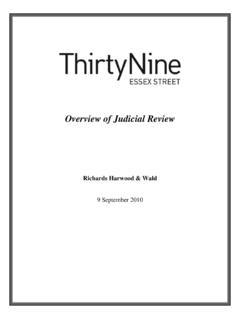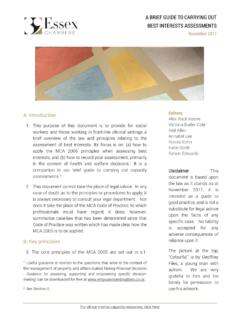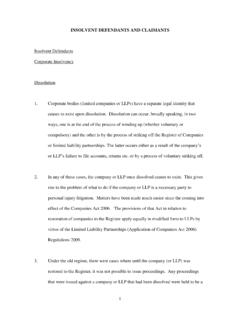Transcription of RECENT FOIA/EIR/DPA CASE LAW IN RELATION TO MPNs ...
1 RECENT FOIA/EIR/DPA CASE LAW. IN RELATION TO MPNs, vexatious . REQUESTS, strike outs AND COSTS. RORY DUNLOP. Thirty Nine Essex Street Introduction 1. The purpose of this paper is to cover RECENT case law in the following areas: (1) Monetary Penalty Notices;. (2) vexatious /Unreasonable Requests;. (3) strike outs ; and (4) Costs. (1) Monetary Penalty Notices 2. So far there have been three FTT decisions and one decision of the Upper Tribunal in RELATION to monetary penalty notices (MPNs). The first was Central London Community Healthcare NHS Trust v IC (EA/2012/00111). The appellant Trust had been faxing highly sensitive medical information in RELATION to patients receiving palliative care to the wrong fax number. Eventually a member of the public telephoned to say that he had been receiving these faxes and shredding them. The Trust reported itself and cooperated fully with the investigation.
2 The Commissioner decided to fine the trust 90,000 but offered a reduced penalty if the Trust chose not to appeal. 3. The Trust chose to appeal and they continued their appeal right up to the Upper Tribunal which gave a decision on 8 November 2013 - Central London Community Healthcare NHS. Trust v IC [2013] UKUT 0551 (AAC). The Trust lost on every ground. The principles that emerge from the litigation are: (1) The FTT's jurisdiction under section 49 of the DPA mirrors that under section 58 of FOIA in an appeal against, a MPN, the FTT can re-consider the issues afresh (and could even impose a larger fine than the IC) see 50, 54 of the UT decision. (2) However, when the issue is the quantum of a MPN, the FTT will look at whether the fine is within a range of reasonable figures' see 139 of FTT decision. 2. (3) The IC was not required to keep its offer of a reduced penalty open whilst an appeal was pending, or to allow a reduced payment to be made under protest.
3 The purpose of the scheme was to encourage early payment and to ensure an early resolution to the matter. There is no provision for a without prejudice payment. This is not a fetter on the right of appeal - 71 of the UT decision. (4) The carve out' under s. 55A(3A) of the DPA only applies where the information comes to light as a result of a voluntary audit. The mere fact that a data controller has reported themselves and cooperated does not mean that it cannot be fined see 24 of the UT decision. (5) Self-reporting is not a significant mitigating factor because it is a legal obligation and cooperation is the least that could be expected'. The absence of evidence of further dissemination is not a powerful mitigating factor if there is no absolute guarantee'. that the data has been destroyed see 128 of the FTT decision. 4. The other two appeals concerning MPNs were Scottish Borders Council v Information Commissioner (EA/2012/0212) and Niebel v Information Commissioner (EA/2012/0260).
4 5. Scottish Borders Council v Information Commissioner (EA/2012/0212) began with an overflowing bin outside Tesco, where a member of the public found files containing the pension records kept by the appellant local authority. A data processing company had turned Scottish Borders files into CDs and then dumped the files in bins. So far as anyone was aware, no actual harm resulted. The ICO imposed a MPN of 250,000 on Scottish Borders. 6. The FTT allowed the appeal, holding that: (1) there could be no liability for contraventions before came into force ( before 6 April 2010) para. 15. (2) The ordinary civil standard of proof applies, not the criminal standard para. 20;. 3. (3) Scottish borders were in contravention of DPA, Schedule 1 Part 2, para 12(b) because its contract with the data processor did not impose the same obligations on the processor as it had itself para.
5 32. (4) It was necessary to focus on the likely harm that would flow from the contravention, rather than from the trigger incident ( what happened at the paper recycling bin) . para. 38. (5) The test of likelihood' requires something more than a mere possibility para. 43. (6) In this case, the contravention was not likely to cause substantial damage or distress. The data processor had a relationship of 25-30 years with the council and they had good reason to trust him. What happened was a surprising outcome, not a likely one. 7. Niebel involved a company that was engaged in sending unwanted text messages on an industrial scale' seeking potential claims for mis-selling of PPI loans or accidents, contrary to Regulation 22 of the Privacy and Electronic Communications (EC Directive) Regulations 2003. The FTT held that test under s. 55 that the contravention be of a kind that was likely to cause substantial damage or substantial distress' was not a balance of probabilities' test (see para.)
6 10 of the FTT decision and R (Lord) v Secretary of State for the Home Department [2003] EWHC 2073 (Admin) at [99-100], where likely' was held to mean a very significant and weighty chance', although not necessarily a more than 50% chance). 8. The FTT also held that substantial' was qualitative and quantitative. Substantial' reflects the seriousness of the harm and how widespread it might be (see para. 11). It was, as a result, very important, in a case like Mr Niebel's, that the number of texts be included in the Commissioner's description of the contravention. Looking at the 286 texts in the contravention, the FTT found that it was unlikely they would cause substantial damage or distress. 4. (2) vexatious /unreasonable requests 9. Three Upper Tribunal (UT) decisions were handed down on 28 January 2012, addressing the proper test to be applied in deciding whether requests are vexatious (s14(1) FOIA) or manifestly unreasonable (Reg 12(4)(b) EIRs).
7 10. IC v Devon County Council and Dransfield [2012] UKUT 440 is now the leading case on s14(1). A vexatious request is one which involves a manifestly unjustified, inappropriate or improper use of the FOIA procedures. Characterising a request as involving such misuse, or as vexatious requires considering four (non-exhaustive) themes: . (1) the burden - on the public authority and its staff. This involves considering the previous course of dealings with the requestor, looking at factors such as the number of requests, their breadth or the pattern of their arrival;. (2) the motive - of the requester. That FOIA is motive blind does not mean that there can be no examination, under s14, of the justification for the request , or its motive. It may be ill-intentioned , or have drifted so far from its original purpose as to become disproportionate. (3) the value or serious purpose of the request .
8 The UT recognised the potential for overlap with (2), and also cautioned about jumping to conclusions about a lack of serious purpose; but there should be an objective public interest in the release of information sought. (4) any harassment or distress, of and to staff by the use of bullying language etc. This was not, however, a prerequisite for the application of s14. 11. Craven v IC and DECC [2012] UKUT 442 addressed manifestly unreasonable EIR. requests. It confirmed that the test under the two regimes was, for practical purposes, the same. It follows that if there is uncertainty about which regime applies, public authorities may address requests on an either/or' basis. Further, an authority is entitled to refuse a single 5. extremely burdensome request as being manifestly unreasonable , purely on the basis that the cost of compliance is excessive. This represents an important protection for public authorities.
9 12. Finally, in Ainslie v IC and Dorset CC [2012] UKUT 441 (AAC) the UT expressly confirmed current understanding of the FTT's appellate jurisdiction: the FTT may undertake a full merits review of the Commissioner's decision . 13. In response to these judgments, the Information Commissioner updated his guidance on vexatious requests. 14. In the summer of 2013 there were a couple of decisions in RELATION to manifestly unreasonable' requests. Although they followed Craven in finding that manifestly unreasonable' is coterminous with vexatious ', the FTT did not agree with the IC's importation of the FOIA time limits into EIR. This raises questions about the extent to which the approach taken to vexatious requests under the FOIA can be transposed to requests made under the EIR. 15. In Yeoman v Information Commissioner (EA/2013/0008) the IC's approach was overruled by the FTT.
10 The case concerned requests for disclosure, from Cornwall Council, of all section 106 agreements' ( - agreements between developers and local planning authorities that are negotiated under the Town and Country Planning Act 1990 as part of a condition of planning consent). When reaching the conclusion that the request was manifestly unreasonable, the IC had taken into account: (1) the length of time that it would take the public authority to respond to the requests (the Council estimated this would be around 28 hours 47 minutes);. (2) the effective time limit of 18 hours in RELATION to FOIA applications. There was no similar effective time limit under the EIR, but, the IC felt that the time estimate was so far in excess of the FOIA limit as to render the request clearly unreasonable'; and (3) whether the public interest test favoured non-disclosure. The IC concluded that given the time involved in meeting the request , this would disrupt the Council's core duties'.









